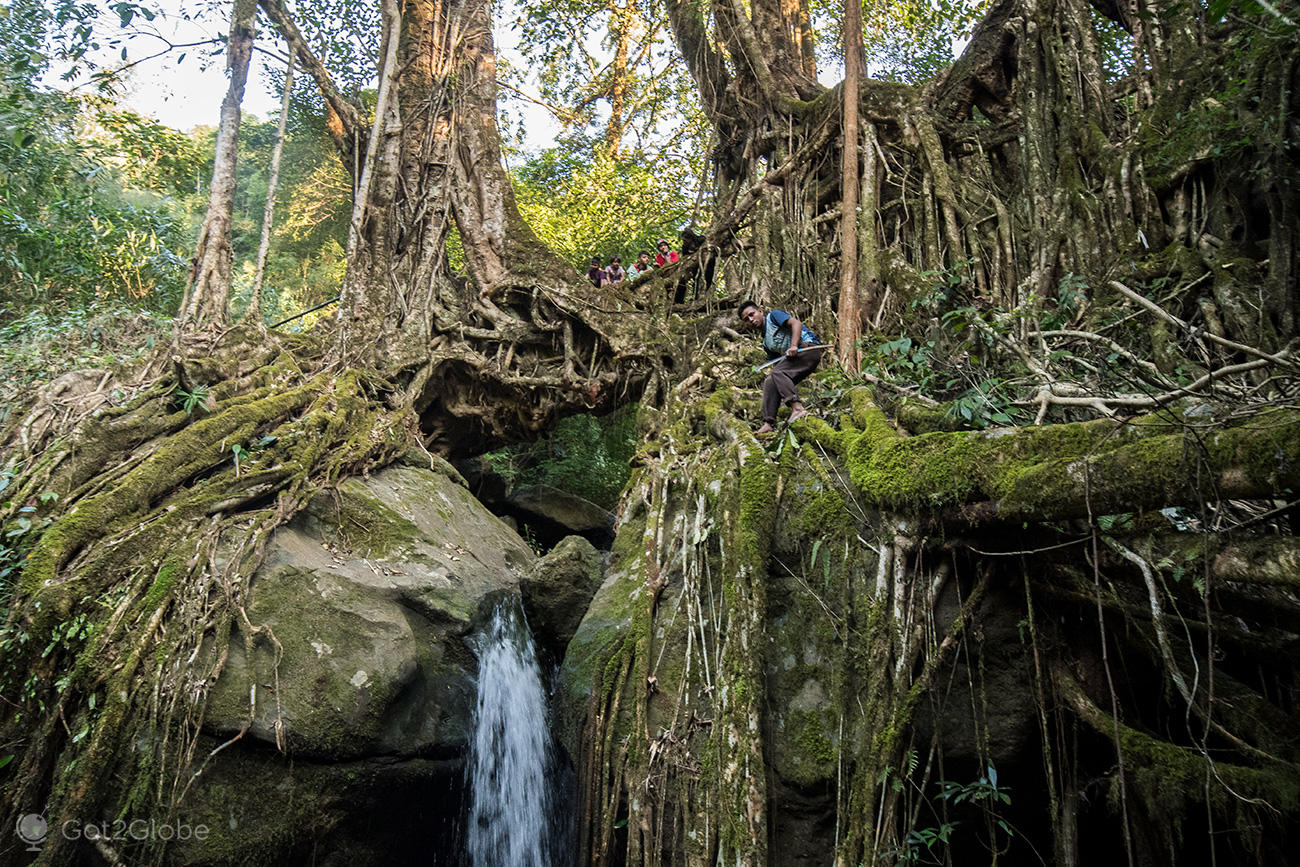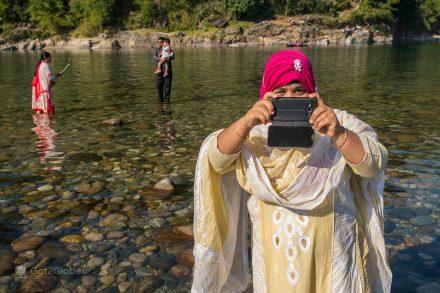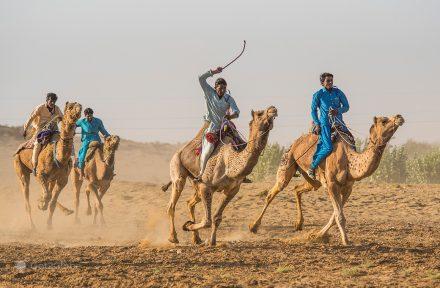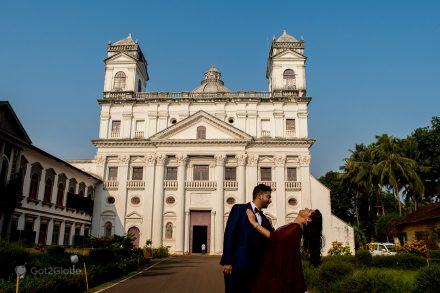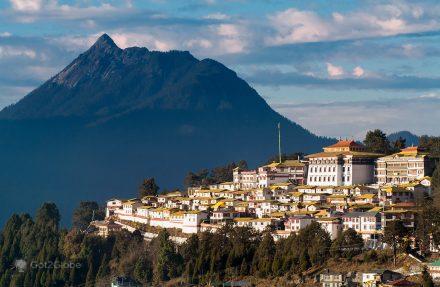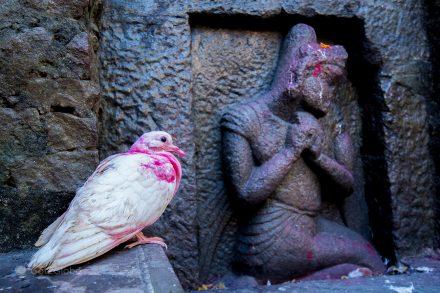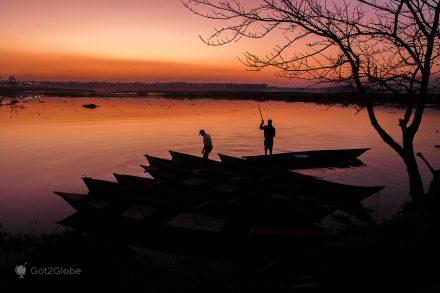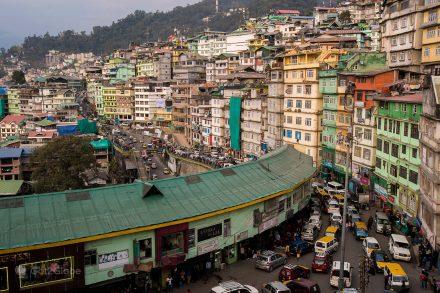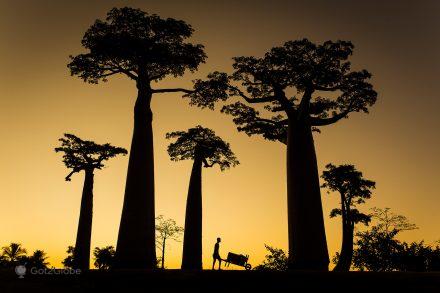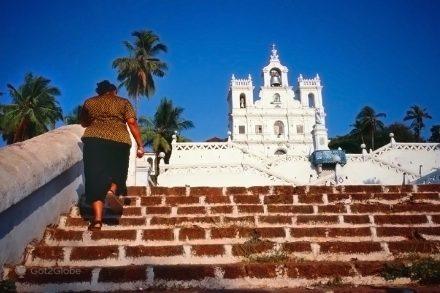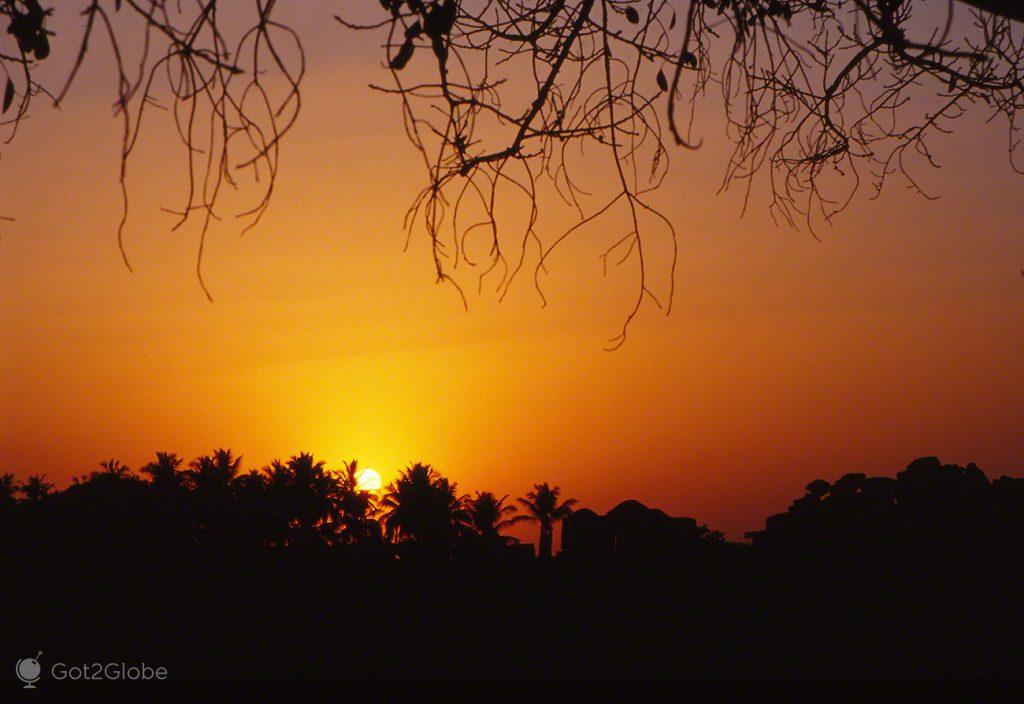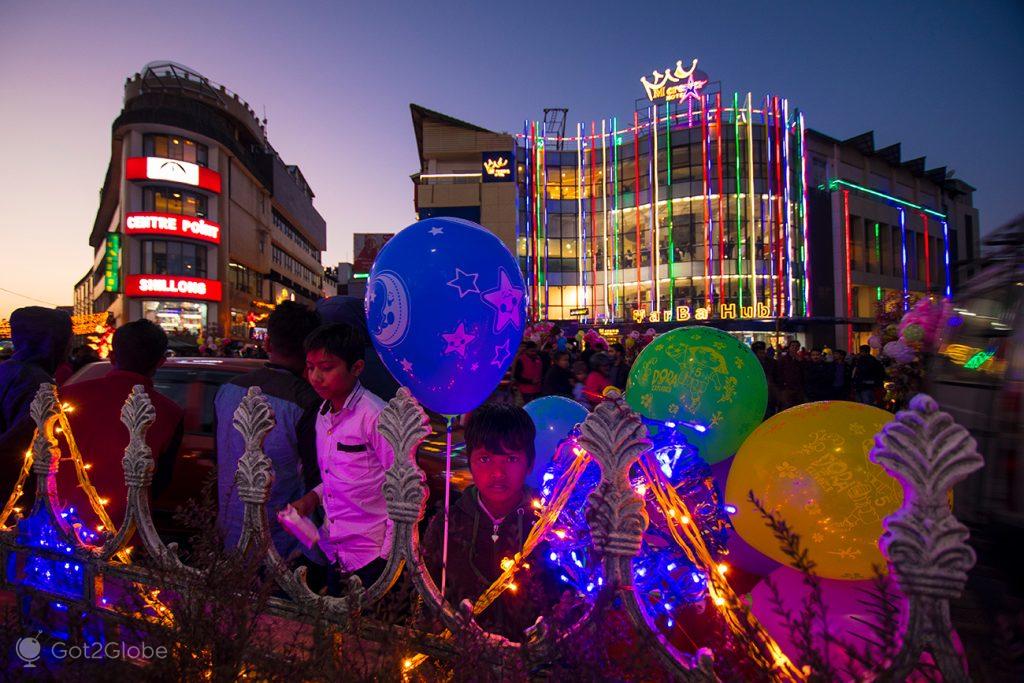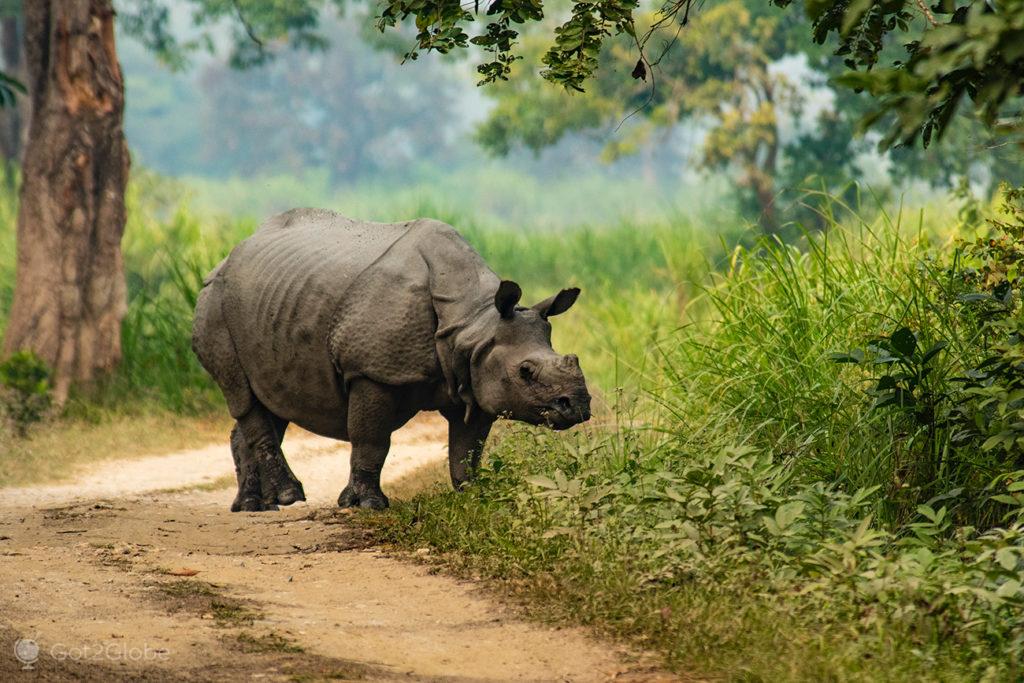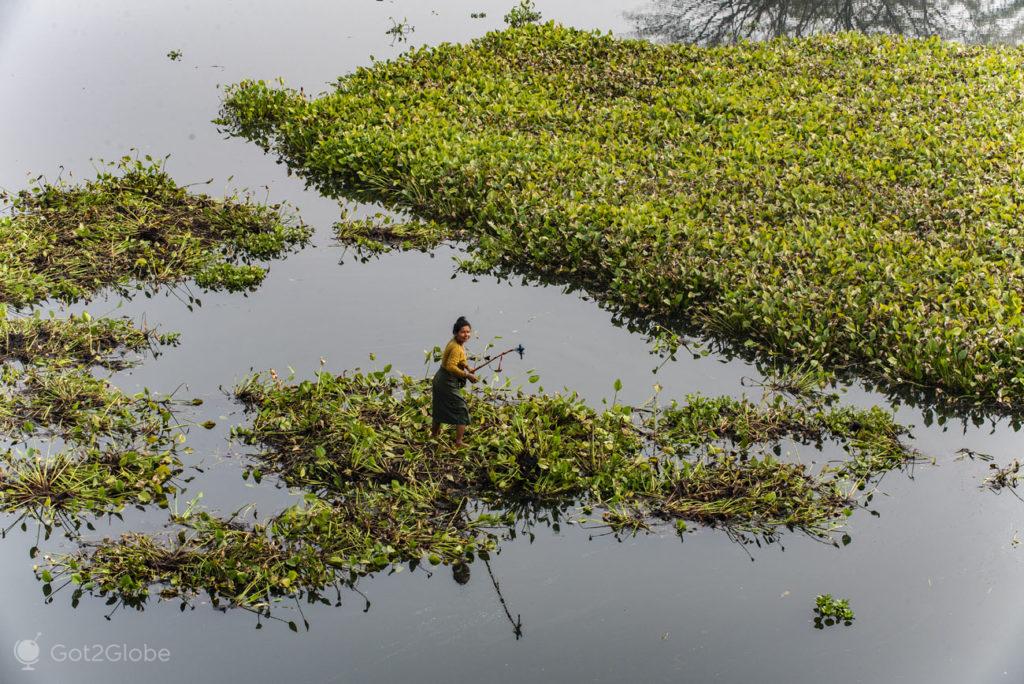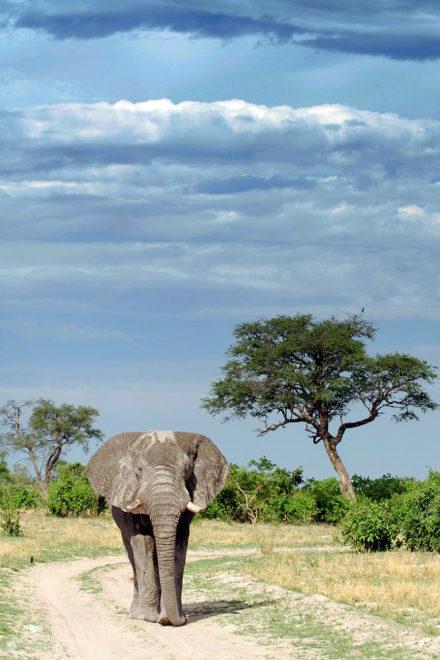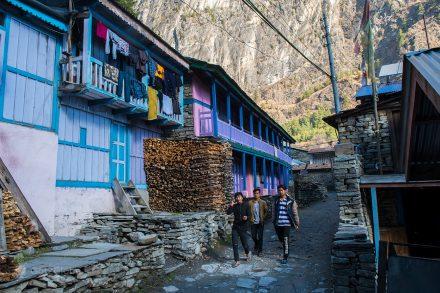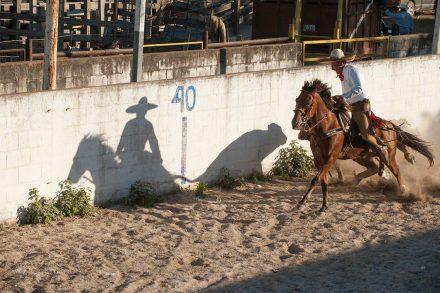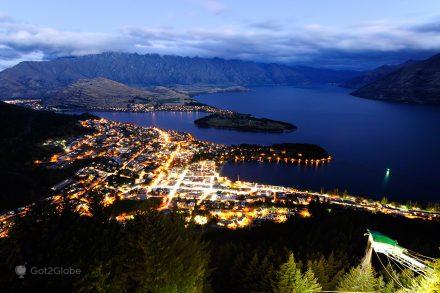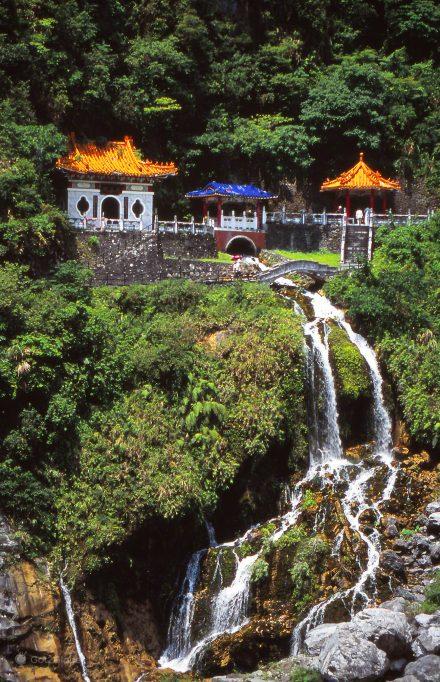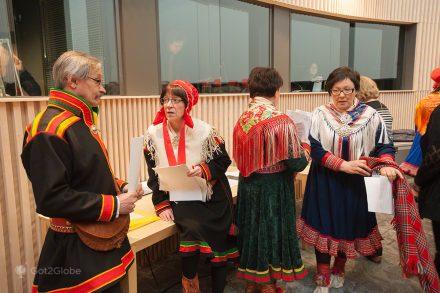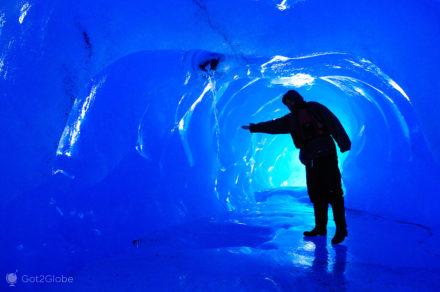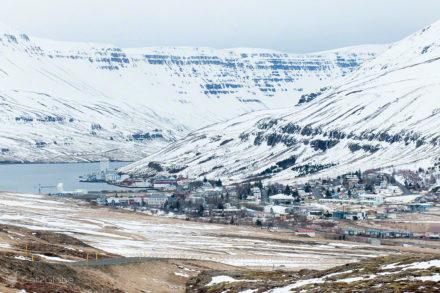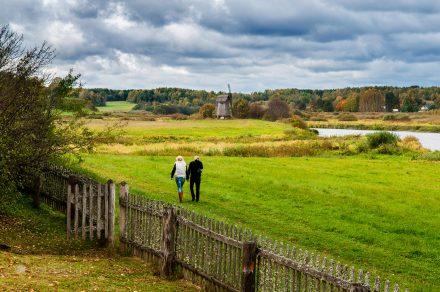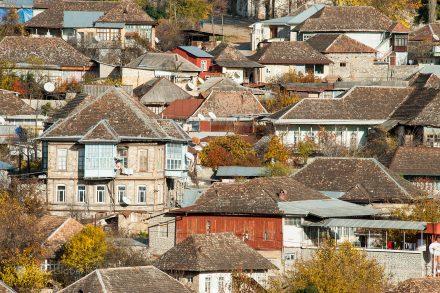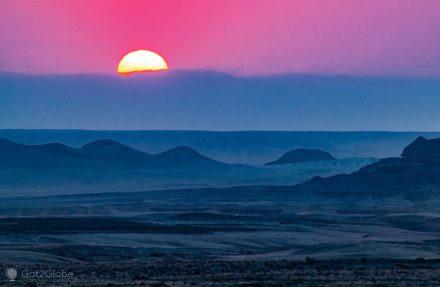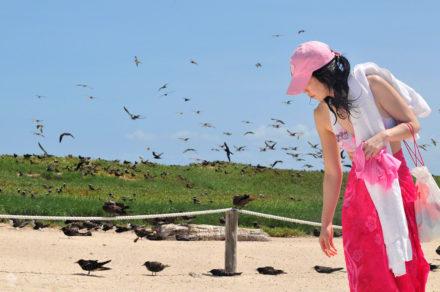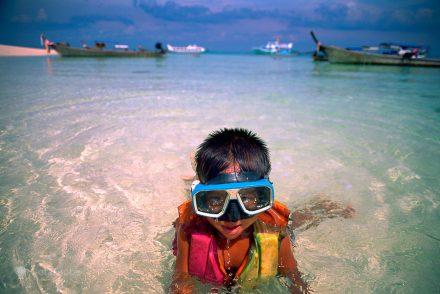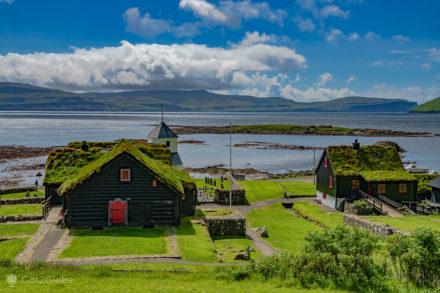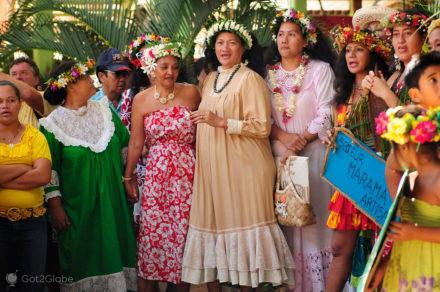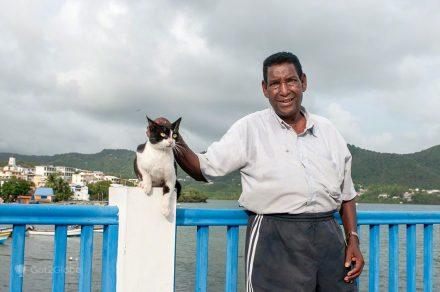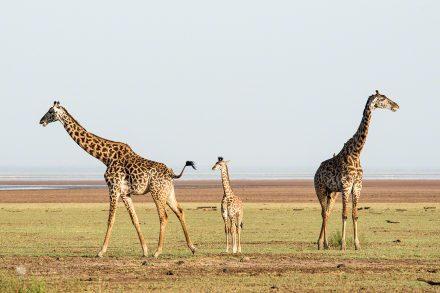It was far from the reality of Christmas days that we pass by: sunny during the day, cooler after sunset, but dry. The province of Meghalaya, which translates as “abode of clouds”, is by far the wettest in India.
It has several villages in the top 10 of the world's rainfall. Of them, Cherrapunjee and Mawsynram boast numbers in the order of 25.000 mm annually. They compete for the absolute record against each other and with other Colombian towns.
As a rule, when May arrives, the heat generates intense evaporation from the Indian Ocean, Arabian Sea and the Bay of Bengal. Moisture-laden clouds are pushed over the subcontinent by southerly winds. The higher the nearby land, the more rain it provides.
Now Meghalaya occupies the plateau above the alluvial Bangladesh, a few kilometers from the coast of the Bay of Bengal. We soon noticed the rupture in the landscape between the two regions.
We were based in Shillong, the state capital. From there we left morning after morning heading south. On one of these journeys, we left with Cherrapunjee as our final destination.
A lot of twists and turns through hills and valleys later, Gus and Don, the driver and guide who helped us discover the province, brought the car to a halt at the edge of a horseshoe-shaped cliff lined with vendors. As soon as we approached the cliff, we realized how the scenery and the different views we had seen before mirrored the contrast between the two weather times of the year.
A distant waterfall – by the way the highest in India, at 340 meters – falls from the forested top of the plateau into a lagoon between green and blue.
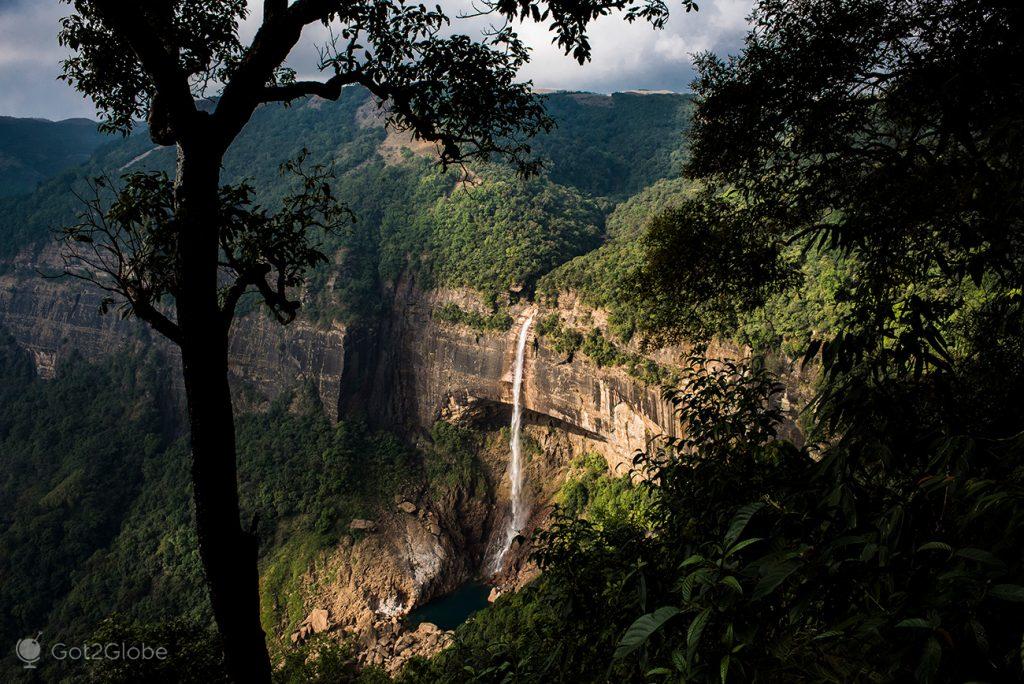
The highest waterfall in India at 350 meters. It plunges into a huge drop in the Shillong plateau, Khasi Hills.
The Impressive Nokhalikai, or Seven Sisters Falls
Its English-speaking name, Seven Sisters Falls, alludes to the fact that, in the rainy season, the jump we saw there multiplied by seven, each representing one of the states of the distinct North-East India: Assam, Arunachal Pradesh, Tripura, Nagaland, Manipur , Meghalaya and Mizoram.
In the middle of the more-than-soggy monsoon phase, clouds fill the natural amphitheater at the foot. They also invade and irrigate most of the lush, rugged area above the Nohkalikai, the Khasi (local dialect) name for the waterfall, inspired by a legend involving Likai, a local woman, her son, husband and familiar cannibalism. In such a macabre way that we refuse to go into detail.
On really rainy days, more than a sequence of vertical torrents, the Nohkalikai come from every groove in the relief. They become a fluvial list hidden by the mist that always hangs there.
After the final chuáa of the impact on the rocks at the base, its flows continue, full, towards the Bangladesh's sandy plains. Along the way, they pass a series of self-degraded Khasi and Jaintia villages deep in the valleys.
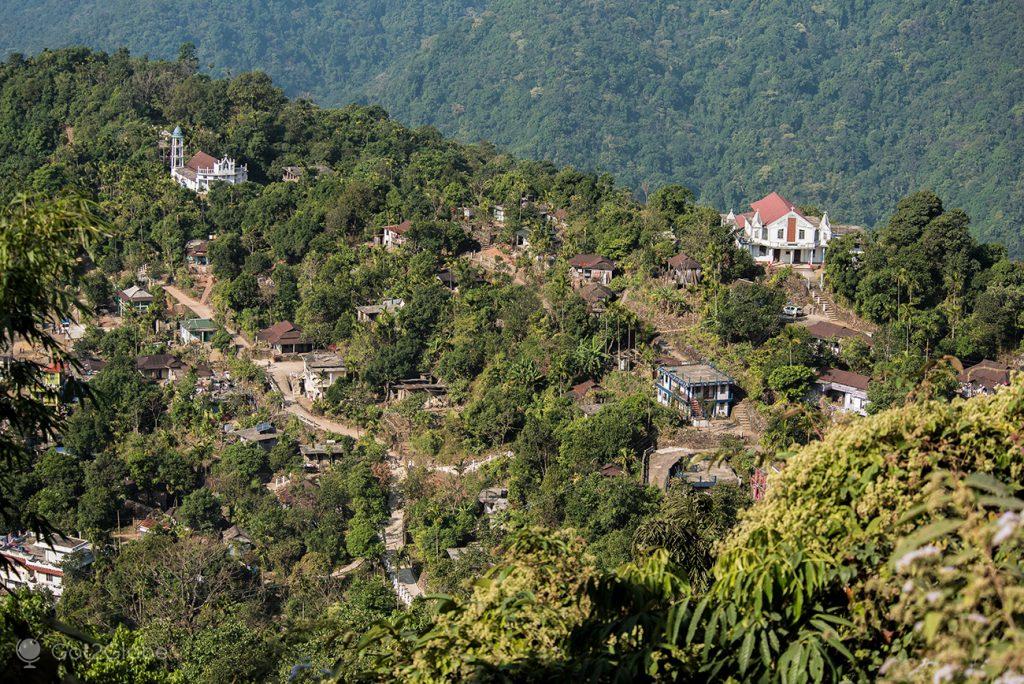
Village of the Khasi Hills above Nongriat, downstream from the base of the Nohkalikai waterfall.
Peoples of the Deep River Valleys
A few days later, on the way back from Nongblai, one of those villages, we asked the young native guide Morning Star Kongthaw what had caused people to inhabit such painfully accessible places. Morning Star hardly adorns the explanation: “Centuries ago, survival wasn't like it is today. Families had to find reliable food sources.
The rivers flowed down there. In addition to guaranteeing them fish and other animals, they allowed the cultivation of vegetables and fruits. For people, tiredness had little meaning compared to having their lives assured. For many, it's still like that.”
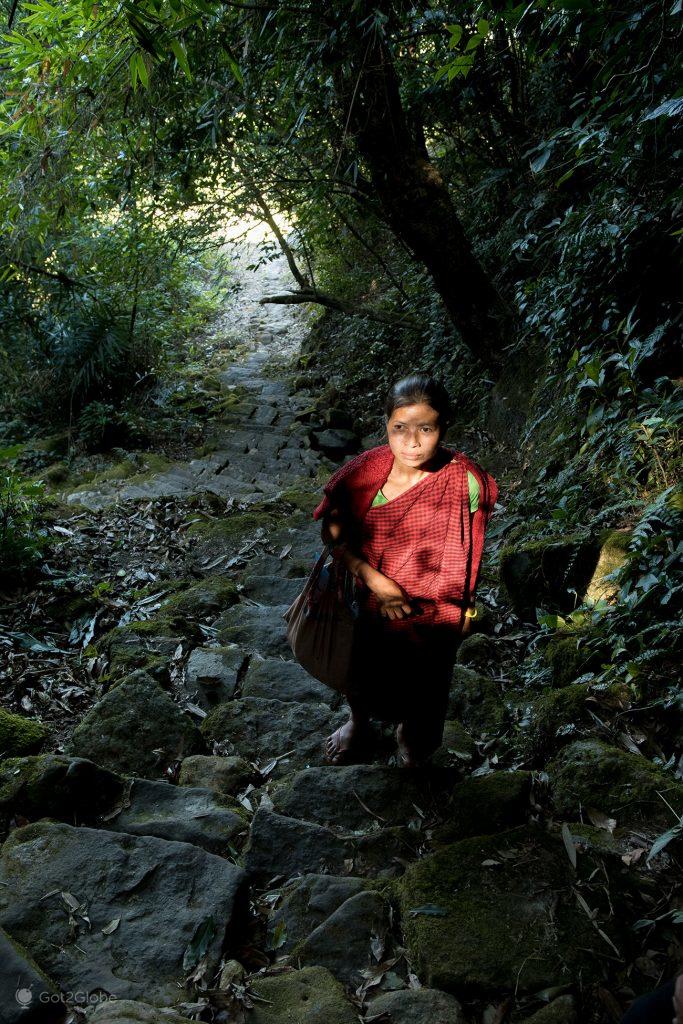
A resident of Nomblai on a shady stretch of the village's long climb to the top of the valley in which it is located.
Two ethnic groups in particular occupied the fertile riverside corners of Meghalaya. They were the Khasi and the Pnar, or Jaintia, both matrilineal and that the British missionaries converted to the point where the Khasi and the Pnar formed, in Meghalaya, the most Christian and possibly less “Indian” state in India, where people share a notion of individual space and modesty towards others, uncommon in the subcontinent.
As we explored it, Meghalaya kept surrendering to intense christmas celebrations, as no other Indian state did.
When they settled at the bottom of the valleys of the Khasi Mountains, both the Khasi and the Pnar had to learn to obtain food from the streams and its banks. But not only. They were forced to anticipate the huge seasonal fluctuations in the volume of rivers and the room for maneuver to safeguard their homes and crops.
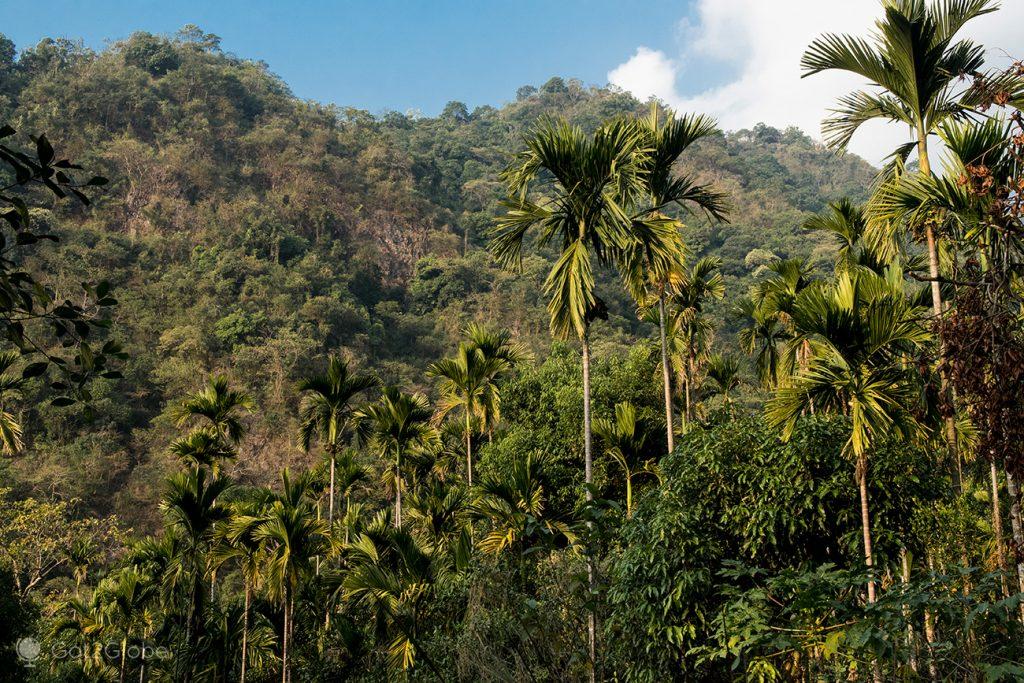
Betel nut palm forest, consumed in large quantities in Meghalaya and also in Nongblai.
The Roots Bridges of Nongblai and So Many Other Villages
The other question requiring the best of your ingenuity was how to guarantee the crossing of the increased flows. The solution they came up with excelled in an astonishing organic pragmatism, much more moldable and resistant to raging torrents than steel and concrete, and virtually free of charge.
Now that tourism has arrived everywhere and knocked on their door, it fascinates the rest of the world. In many cases, it also represents a fruitful livelihood.
We began the incursion into Nongblai, this time led by Saddam, a Hindu chauffeur, more than a peculiar, tragicomic one. We picked up Morning Star a few kilometers from the beginning of the long staircase we had to walk.
For a good hour, we descend the high, uneven stone steps and, in shady areas, covered with slippery moss, the guide tells us that, during the rainy season, it formed a huge green carpet. At that time, we only saw the diverse vegetation that surrounded the stairs and the other side of the valley.
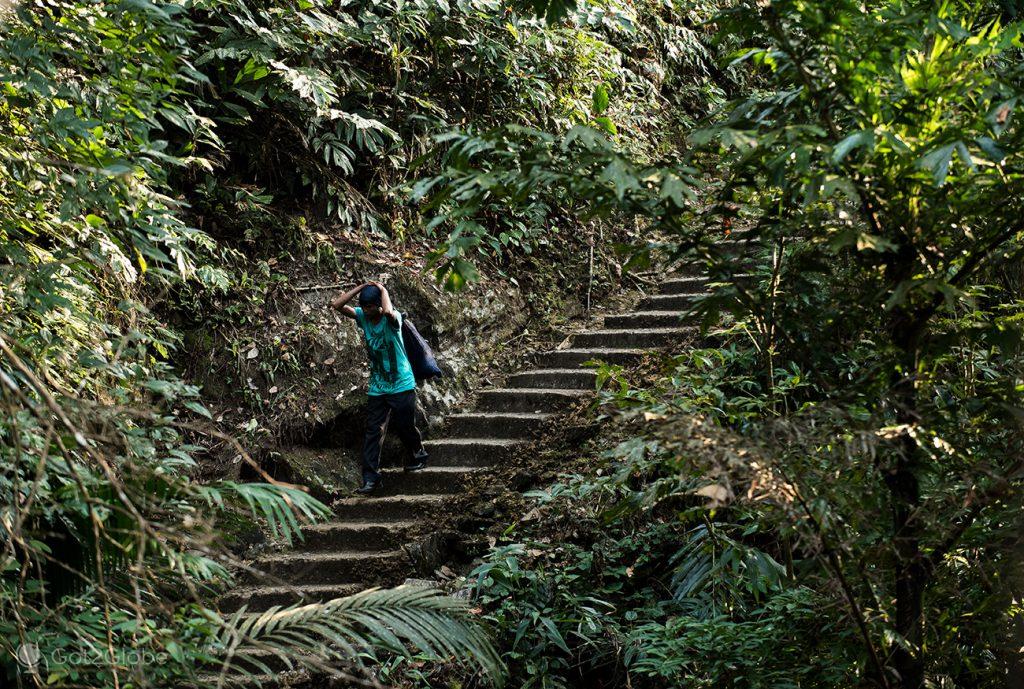
Young man from Nongriat descends a staircase, loaded, about to reach his village
We are faced with only two or three villagers coming from the ascending direction, less tired than we might suppose. Finally, we saw the river's furrow and glimpsed the village's houses a few dozen meters above.
The ritual was sent to receive us by the head of the village. Morning Star even teaches us a few words in Khasi dialect – for example, the ever-helpful thank you, khublei shibun – but Longneh Khong Sni, in English, spoke nothing so all communication flowed through the guide.
Morning Star tells us that the Meghalaya tourism authorities had warned him of our visit at the last minute. As a result, the chief's family had not been able to welcome us as they would have liked.
The Providential Reception of Longneh Khong Sni
The descent had left us hungry. The hosts knew it. In agreement, they tell us to settle down on the wooden floor of the small stilt house and serve us tea, then white rice with an omelet, which we devour as if it were the most irresistible delicacy.
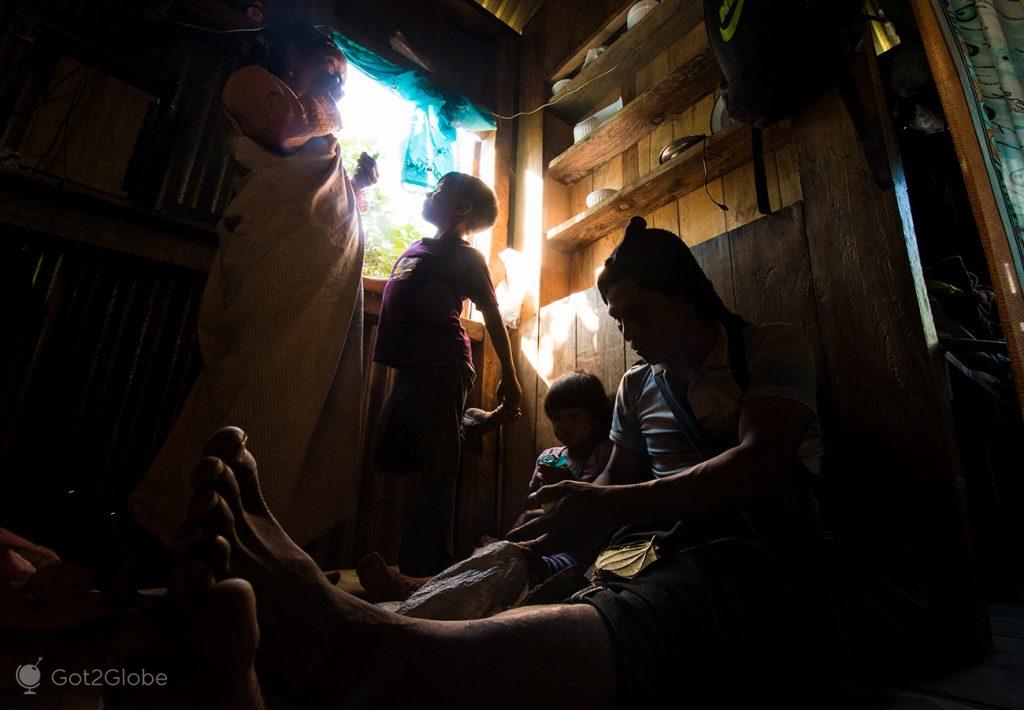
Chief Longneh Khong Sni's family in the room of his tiny stilt house in Nongblai village.
When the meal is over, the chef puffs on his pipe. I take the Morning Star ride and try for the first time chewing betel nut, so popular in those parts, all over India and Asia.
The taste turned out to be horrible. As if that wasn't enough, the semi-acid liquid gave me a huge cold sore. After ten minutes of accentuated salivation, I spat the reddish liquid in relief, washed my mouth and swore never again. "Just go there with the habit!" Morning Star assured me, stifling a laugh. By that time, I was convinced it was something I would never get used to.
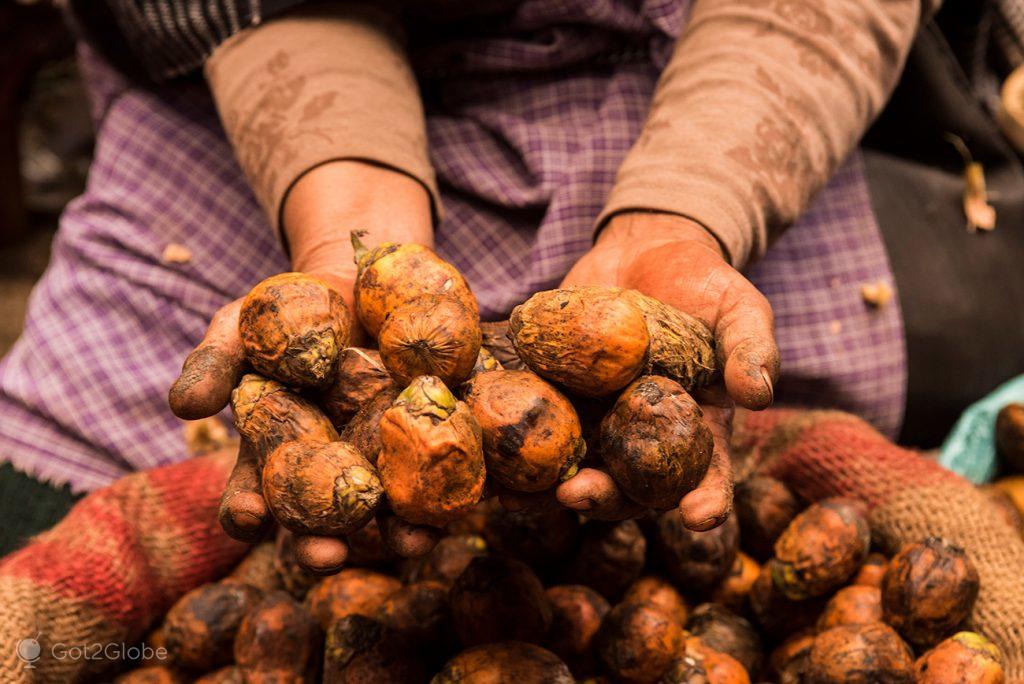
The yellowish fruits that are addictive and stimulate a good part of the population of Meghalaya, India and Asia.
We left the chief's home aimed at the river. It had been more than three hours since we had left the comfort of the Shillong hotel with a clear purpose in mind. An additional ten minutes of walking later, we come across the tour's superior reason for being: Jingkieng Wahlangseng.
Jingkieng Wahlangseng, the First of the Root Bridges
A massive, mossy tree bridge hugged the vast bedrock, with profuse aerial roots stretching from the thickest trunks, lined, braided, and carved to form a secure walkway. Others, younger and thinner, fell into the clear water in decorative fringes.
By intervention of the villagers of Nongblai who guide them with bamboo canes, the rubber tree (elastic fig tree) that had spawned it, had grown sideways, with powerful branches pointing in the direction where the sun crept in before disappearing behind the mountain.
We crossed it to and fro in absolute vegetal ecstasy. Meanwhile, the chief installs himself on the trunk in the company of two of his infant sons. He takes a few last breaths and is left to contemplate, in pure tranquility, the blessed scene in which he lived.
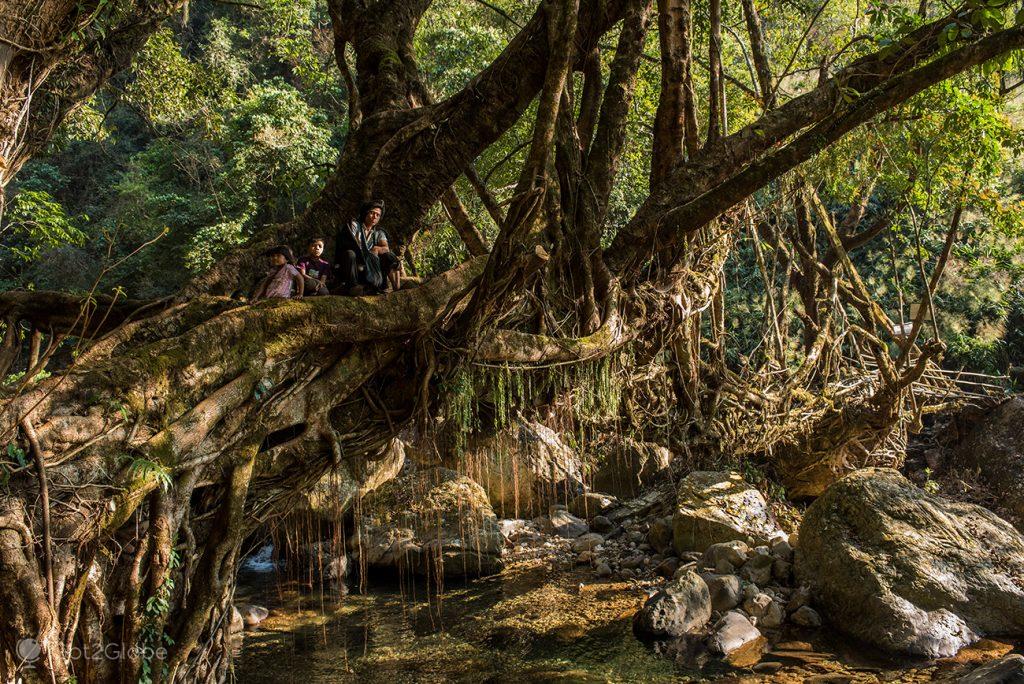
Chief Longneh Khong Sni with two of his sons over one of the bridges in the village of Nongblai.
"Did you like this one?" asks us Morning Star. In Meghalaya there are hundreds. It takes almost half a century to reach this size, but if no one cuts them, they just get bigger and stronger. Here, in the village, there are another five. Let's go to the next one?”.
In Search of the 2nd: Jingkieng Wahsurah
Of course we were. Too bad we don't have time to follow Morning Star for days, weeks on end, through the valleys of Meghalaya. To discover them, enjoy and cross them all, preferably in the rainy season when the landscape is even more lush and green.
Jingkieng Wahsurah, the bridge that followed, appeared in a sector of the same river cut by a large terrace and which housed a waterfall. The light entered there much less than in the area of the previous bridge.
Yet, for more than a century, the elastic fig tree The resident had developed and greedily released its tentacles there. We were barely aware if the branches and roots covered by the moss belonged to one or more specimens.
Morning Star is gone. When we discovered him from the bridge, he was perched on one of the branches that extended downstream, photographing the bridge from below.
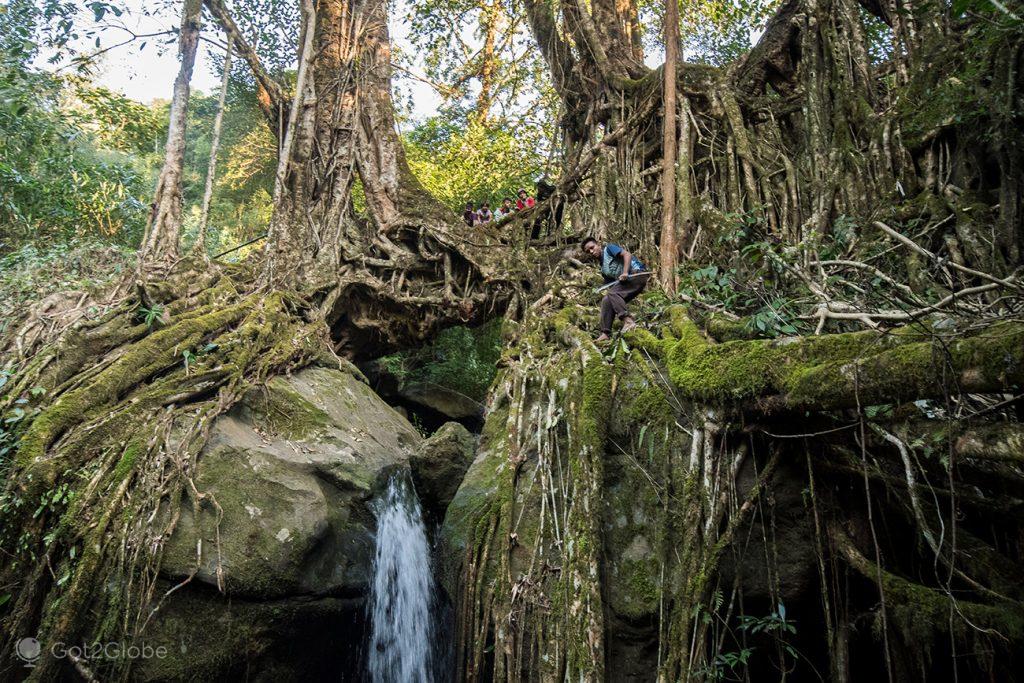
Another bridge from Nongblai's roots that crosses the river on the banks of the village just above a waterfall.
We couldn't resist joining him along the same steep trail. To the astonishment of the village chief's children and two other newly-appeared children, little or not used to seeing strangers on such adventures.
The sun was already insinuating the southern edge of the valley and we still had two hours or more back in the highlands. Aware of the added difficulty of climbing in the dark, Morning Star urged us on.
We returned to Longneh Khong Sni's house, thanked him for the privilege of visiting the village and said goodbye to his wife and children. The chief had a meeting in the village at the top of the stairs, so he went up with us.
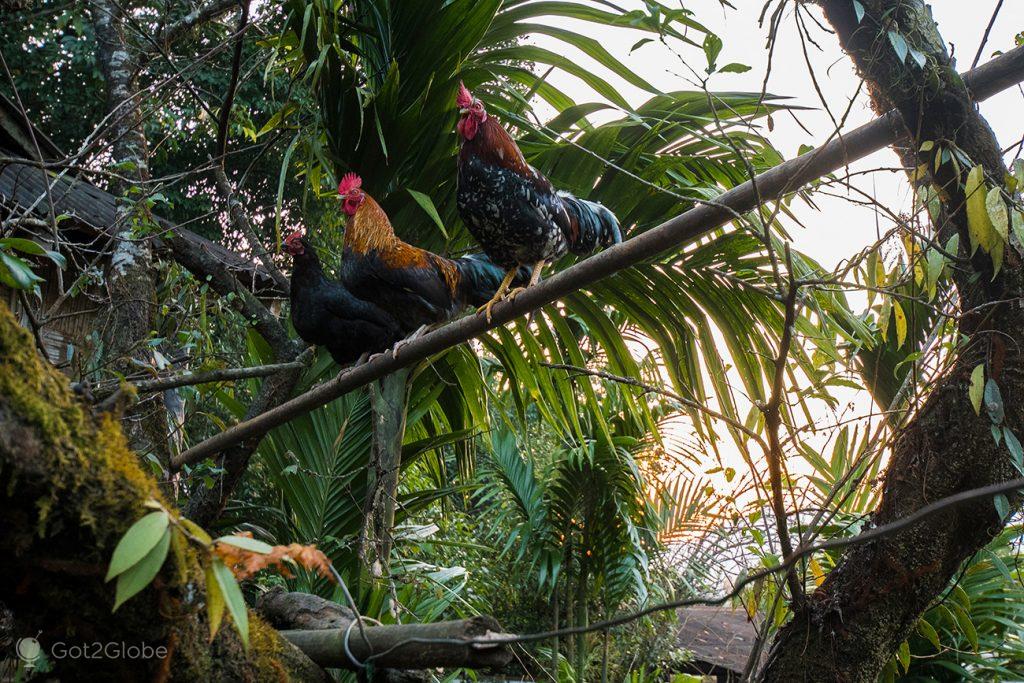
Alarm clocks recharge for late-night service
Back to the Meghalaya Highlands
Until more than halfway through, we completed the ascent tired but without too much complaining. From the hour and three quarters, with the pitch installed and the legs giving way to the weight of the photo backpacks and the intense wear and tear, we almost dragged ourselves to reach the last step, always encouraged by Morning Star who entertained himself to renew the promise that only five minutes to go.
We still had tea together masala at a local tea house. Finally, we climb into the car, given to Saddam's whims. We were both about to fall asleep, lulled by the curves, when we noticed that the driver had a video player installed over the steering wheel.
He saw some Bollywoodesque success as he led us down the road, which was almost always flanked by cliffs. Even so, we arrived safe and sound at Shillong. We spent the next day sore like we hadn't felt for a long time.
The beating did not deter us from repeating the dose.
Two days later, we descended (and, of course, climbed) 3000 or more excruciating steps to the depths of Nongriat. There we met and revered 180-year-old Umshiang. One of Meghalaya's amazing but rare root double bridges. Probably the most visited in the state, worthy of its own story.
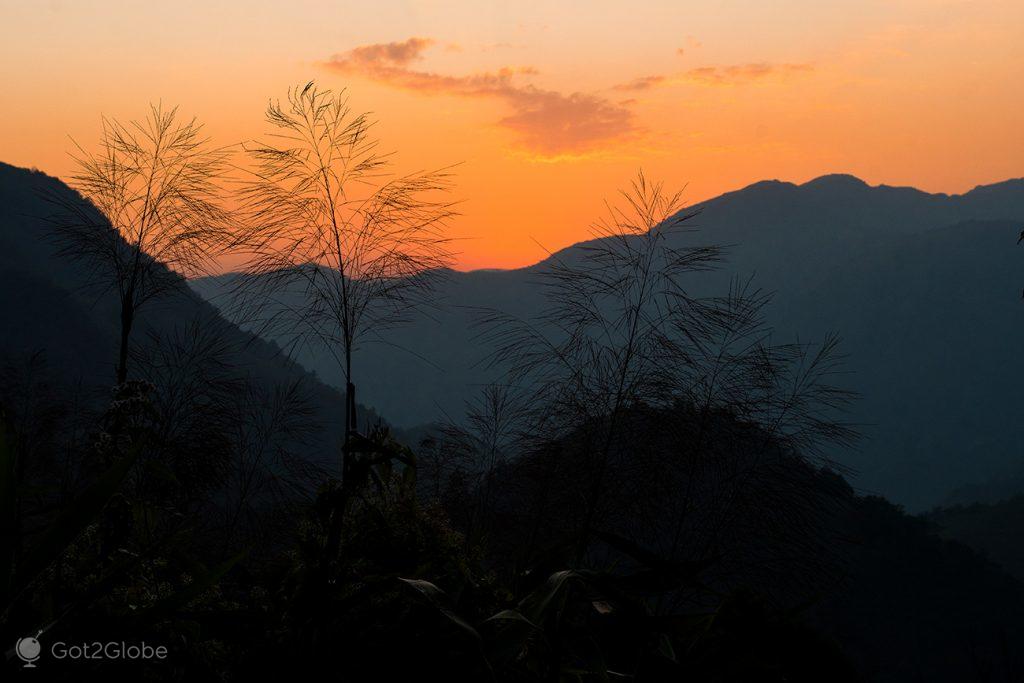
Sunset ends another productive day in Nongblai at around 17pm.
The authors would like to thank the following entities for supporting this article: Embassy of India in Lisbon; Ministry of Tourism, Government of India and Meghalaya Tourism.
They would like to thank and advise those interested in discovering this unique region of India to rely on the “native expert in Root Bridges and Meghalaya nature and culture” Morning Star Kongthaw:
Telm and Whats App: +91 80144 70908
Facebook: MorningStar Kongthaw (Bah Morning)
